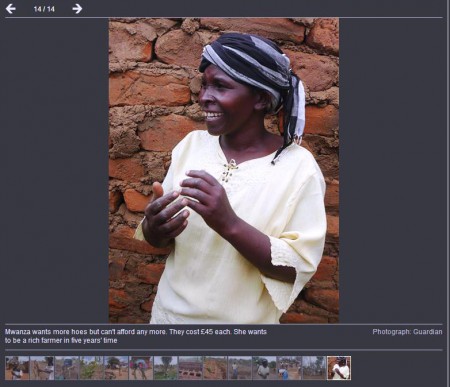- Do polycultures have a role in modern agriculture? Well, do they? h/t The Scientist Gardener.
- Texas breeders go for better melons.
- “Children from the city who try this yogurt don’t like it, but they’re not healthy like my children!”
- Hotspots for Aboriginal traditional medicinal plants mapped to within an inch of their lives, thanks to GBIF.
The price of hoes in Kenya
This post is not really about agricultural biodiversity, but I think it is worth stretching a point on some occasions. Take a look at the caption for this photograph. It’s the last in a gallery from The Guardian which goes with a nice write-up of what sounds like a very worthy Farm Africa project.
Forty-five pounds for a hoe? Forty-five pounds? I must say I’d missed that when I first went through the photos, but when Jeremy pointed it out I had to admit that seemed a bit steep for a hoe.
Well, is it just us? What do we know about the price of hoes in Kenya, right? Internal evidence in the article suggests that £45 is a lot of money, but a fair price for a hoe.
But low-tech can still be costly. Mwanza says she would like more hoes, but at £45 a hoe, it is far more than she can afford. The simple brick house she lives in with one of her children is no bigger than a small bedroom.
But googling comes up with a much cheaper price in Uganda:
“A hoe is a very cheap thing. It costs Shs 7,500 each and when I buy one it can last more than two years,” Nyakoojo said.
That would be about £1.70. And when the wife sent text messages to everyone she could think of in Kenya she got back figures closer to the Ugandan than The Guardian. A very fancy hoe goes for about KSh 1,200, or £8, we were told.
So what’s going on? Normally, I’d probably just dismiss it as a misplaced decimal point somewhere. Or perhaps a misunderstanding about what exactly the tool involved is. But it appears that this “hoe” is the weapon of choice in the Manichean fight against GMOs.
Small African farmers such as Mwanza stand on the frontline in the battle for higher productivity and agricultural development, a struggle being fought not with tractors and GM crops but with hoes, wheelbarrows and indigenous drought-resistant crops: cowpeas, pigeon peas, green grams, sorghum and millet.
So I think we should all be extra clear about what one costs. Starting with The Guardian. And the Gates Foundation.
Brainfood: Sorghum core diversity, Indian mango diversity, Montia potential, Assisted migration, Corchorus diversity, Soil DNA, Fire!, Coffee pest, Earthworms
Making life simpler for you, we have created an open Mendeley group for the papers we link to here. If you’re already using Mendeley, feel free to join the group (and use it to suggest papers we might miss). You can also discuss papers there, but frankly, we’d prefer you to do that here. Or on Facebook. Even if you don’t use Mendeley, you can subscribe to the RSS feed from the group and get stuff that way. Are we cool, or what?
- Variation in flowering time in sorghum core collection and mapping of QTLs controlling flowering time by association analysis. 4 QTLs and 7 loci detected under different conditions. Is that, like, a lot?
- Evaluation of genetic diversity among commercial cultivars, hybrids and local mango (Mangifera indica L.) genotypes of India using cumulative RAPD and ISSR markers. Just one big happy family.
- Montia fontana L. (Portulacaceae), an interesting wild vegetable traditionally consumed in the Iberian Peninsula. Aquatic herb has high fibre and lipids. High oxalate too though. Breeders enjoined to get to work. On Montia. Riiiiight.
- Taking stock of the assisted migration debate. It’s REALLY complicated. Scientists are not that great at explaining it. More work needed all round. But now we have fancy diagrams.
- Genetic diversity and relationships in Corchorus olitorius (Malvaceae s.l.) inferred from molecular and morphological data. Out of Africa. Ethiopia, to be exact.
- Meta-barcoding of ‘dirt’ DNA from soil reflects vertebrate biodiversity. Wonder whether it works with agricultural ‘dirt.’
- The human dimension of fire regimes on Earth. Entertaining gallop through the history of the use of fire to manage landscapes around the world and down the ages. Need to catch my breath here.
- Some like it hot: The influence and implications of climate change on coffee berry borer (Hypothenemus hampei) and coffee production in East Africa. That title just had to come sometime, didn’t it.
- A critique of earthworm molecular phylogenetics. So apparently “molecular phylogenetics is now on the verge of revolutionizing earthworm systematics.” Beyond satire.
Objections to “development”
Fishermen and rice farmers in Cambodia’s Ratanakiri province don’t want dams, electricity or even compensation … They just want to preserve their way of life.
What are they, weird or something?
The villagers in question are objecting to proposed dams on tributaries of the Mekong. And it isn’t as if they want better compensation or anything like that. They just don’t want the dams. They want to keep fishing and growing rice. Ah, but you can’t stop progress, can you?
Nibbles: Primary forests, Lima Declaration
- “…old-growth rainforests are the greatest celebration of life on earth.” Well, maybe.
- Chefs make a stand. Ooooooh, scary.
